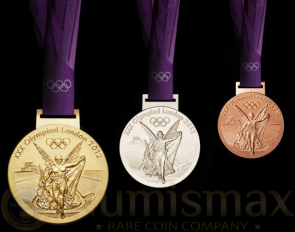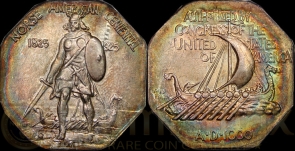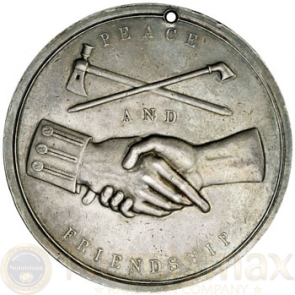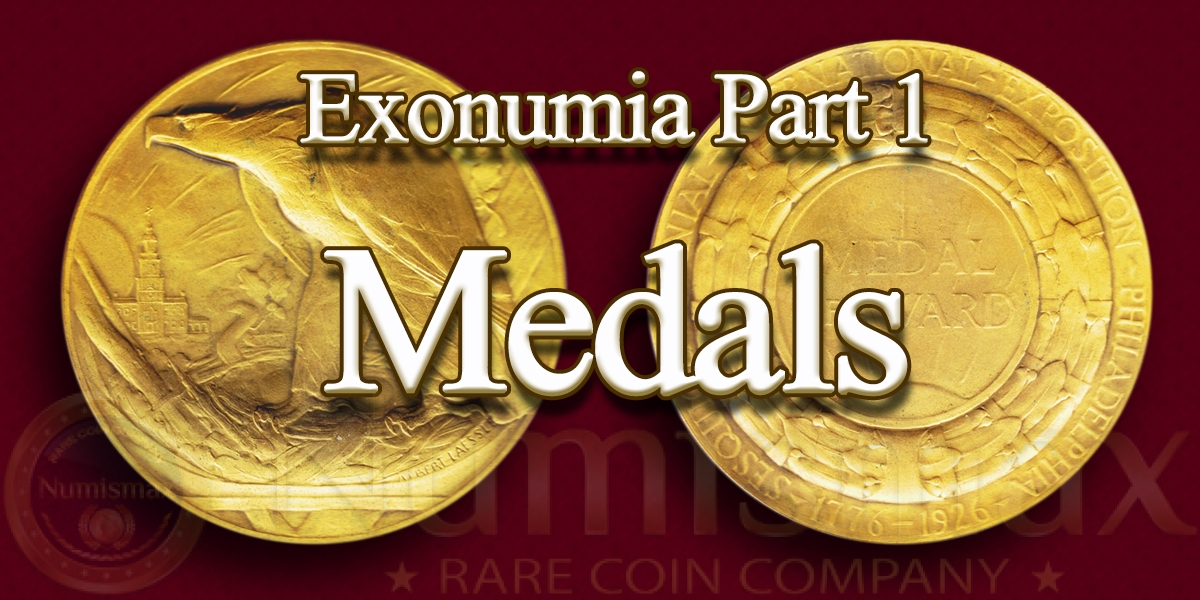Exo-what?!? Exonumia. It’s a catch-all term for numismatic items that aren’t coins or currency. Medals, tokens, and even some coin jewelry and art are all considered exonumia. In this series of posts we’ll take a look at some of the most common categories and what makes them worth collecting. In this first installment of, we’ll talk about Medals.
 Medals, simply put, are coins without a denomination. Labels such as “One Cent,” “Five Cents,” or “One Dollar,” are the key elements separating coins from medals, however, medals do not need to be minted by a government like a coin does. Additionally, there is the strike. A coin is struck such that if you are looking at the obverse oriented to see the devices right-side-up, and you flip the coin over vertically (from top to bottom), then the reverse devices are also oriented right-side-up. A medal is struck such that flipping it horizontally (from left to right, or right to left) will yield the same result. This isn’t always the case, but is so common that the terms “Coin Strike,” and “Medal Strike,” are standard parlance.
Medals, simply put, are coins without a denomination. Labels such as “One Cent,” “Five Cents,” or “One Dollar,” are the key elements separating coins from medals, however, medals do not need to be minted by a government like a coin does. Additionally, there is the strike. A coin is struck such that if you are looking at the obverse oriented to see the devices right-side-up, and you flip the coin over vertically (from top to bottom), then the reverse devices are also oriented right-side-up. A medal is struck such that flipping it horizontally (from left to right, or right to left) will yield the same result. This isn’t always the case, but is so common that the terms “Coin Strike,” and “Medal Strike,” are standard parlance.
Nearly every coin collection that we buy has a medal or two in it. The reason why has to do with our government. It takes a lot of effort to get a new coin design passed through congress. As a result, the mint will sometimes create their own design to sell to collectors, and strike them as medals. The bronze Presidential medals are the most common of this example.
Another commonly collected medal is the Norse American medal. They (there are two, the thick and thin planchets) are considered a part of the commemorative half
dollar series dating from 1892-1954. The octagonal medals depict Leif Erikson sailing to North America in the 11th century. The creators of this thought it might be a “tough sell” to get this passed through congress as a coin, so submitted it as a medal. They are the only medal (not to mention an octagonal item) included in a US coin series.
 Peace Medals are well known, and seldom collected. They were struck on planchets of two sizes in bronze, silver, and gold. They were created in the mid 19th century as tokens of peace and friendship between the US government and the Native American Chiefs. The politics of this aside, the medals are something to behold. They are quite large. The large size is 3.5 inches in diameter, and the small size is 2.5 inches. They are each nearly half an inch thick, and are struck in VERY high relief with the incredible detail that one associates with the US Mint. Not very many were made. The vast majority of them are bronze. Their prices range from expensive to very expensive if you can find one at all. If you do find one, don’t be surprised if it has a hole in it at the 12 o’clock position. Many of the Native American Chiefs put the holes there to wear them as necklaces. This actually lowers the value, but is good proof that it was actually in the possession of a Native American Chief.
Peace Medals are well known, and seldom collected. They were struck on planchets of two sizes in bronze, silver, and gold. They were created in the mid 19th century as tokens of peace and friendship between the US government and the Native American Chiefs. The politics of this aside, the medals are something to behold. They are quite large. The large size is 3.5 inches in diameter, and the small size is 2.5 inches. They are each nearly half an inch thick, and are struck in VERY high relief with the incredible detail that one associates with the US Mint. Not very many were made. The vast majority of them are bronze. Their prices range from expensive to very expensive if you can find one at all. If you do find one, don’t be surprised if it has a hole in it at the 12 o’clock position. Many of the Native American Chiefs put the holes there to wear them as necklaces. This actually lowers the value, but is good proof that it was actually in the possession of a Native American Chief.
Thanks for reading this installment on Medals. In the next installment of our Exonumia series, we’ll take a look at tokens.

